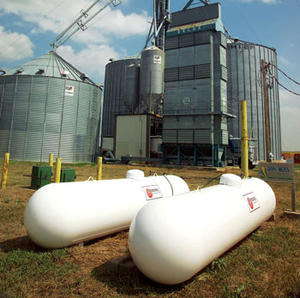Debate over chemical plant security heats up -- again, II
Some lawmakers want to toughen up the chemical plant safety legislation, due for renewal before it expires this fall; the chemical industry prefers the continuation of the current measure, which was passed in 2007; the key debate is over whether or not DHS should be in a position to impose the use of safer and less volatile chemical on those plants closest to large urban centers; the industry points out that many plants have already made the switch voluntarily

Can this plant be kept secure // Source: npga.org
The first part of this article was published on 23 April.
Not long after 9/11 2001, the Environmental Protection Agency (EPA), in consultation with DHS’s predecessor, the White House Office of Homeland Security, drafted legislation that would have required chemical companies to develop security plans using industry “best practices” and to consider “inherently safer technologies” (IST). The agency “didn’t define in excruciating detail what steps were to be taken,” said Bob Bostock, the EPA’s top homeland security policy adviser from 2001 to 2003. Then-EPA administrator Christine Whitman. EPA, already working with the industry to prevent accidental toxic releases, would have been the lead regulator. At the last minute, Bostock said, the Office of Management and Budget (OMB) nixed the plan.
Bostock, now a freelance writer in New Jersey, told Jim Morris of the Center for Public Integrity. “It’s enormously frustrating that we still have to deal with this. This should have been put to bed a long time ago.”
Jim Morris writes in Politico that in arguing for the continuation of DHS’s Chemical Facility Anti-Terrorism Standards, industry representatives say they know best how to assess security risks and, if necessary, modify processes. At last month’s congressional hearing, Stephen Poorman, a FUJIFILM manager speaking on behalf of the Society of Chemical Manufacturers and Affiliates, warned that companies strong-armed into changing technologies could shed jobs. “There isn’t much available capital these days for manufacturers to take on new regulations aimed at their very livelihood, especially small manufacturers,” Poorman said.
Rick Hind, legislative director for Greenpeace, says, however, that the 2009 House bill was the product of significant compromise. During negotiations, he said, the number of facilities that would have had to consider safer technologies and report their findings to DHS was cut by about 80 percent. Under the final version of the bill, only the 107 plants posing the greatest risk of a poison gas release in a densely populated area would have to go through the exercise, and DHS would have to seek expert opinions before forcing any plant to make process changes. But these concessions weren’t enough to win ACC support.
As the debate rages on, operators of some high-risk facilities have acted on their own. Last November, Clorox Co. announced that it would phase out chlorine gas at its seven U.S. plants and start using high-strength bleach (“Clorox Announces Plans to Transition U.S. Operations to High-Strength Bleach,” 5 November 2009 HSNW). “This decision was driven by our commitment to strengthen our operations and add another layer of security,” Chairman and CEO Don Knauss said. Washington’s Blue Plains wastewater treatment plant made a similar switch two months after Sept. 11, obviating the need for as many as six, 90-ton chlorine tank cars on site (“New Survey Shows Many Water, Wastewater Plants Improve Chemical Security,” 9 March 2010 HSNW).
Hind estimates that more than 600 facilities have made such transitions over the past decade. “There’s no rhyme or reason to voluntary conversion,” he said, “and no guarantee that it will continue tomorrow.”
